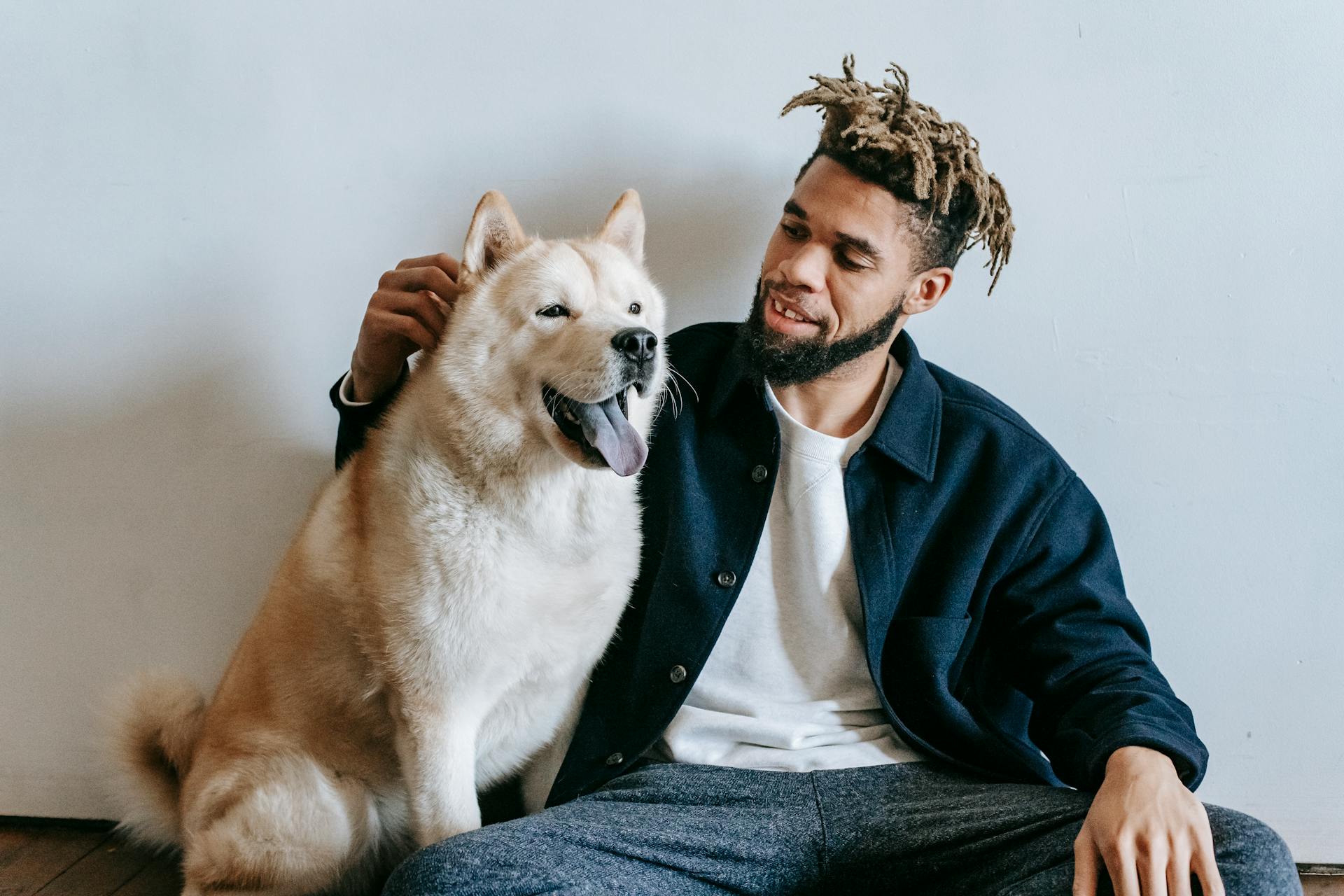
Male dogs mount other dogs for various reasons, including dominance, excitement, and anxiety.
Mounting can start as early as 6 months old, making it essential to address the behavior early on.
Some dogs may mount due to a lack of proper training, socialization, and exercise.
A well-exercised dog is less likely to engage in mounting behavior.
Additional reading: Dog Bone Mount
Why Dogs Mount
Dogs mount for a variety of reasons, and it's essential to understand these motivations to address the behavior effectively.
Dogs of any age may initiate humping behavior, whether with their littermates, other pets in their home, or unknown dogs they meet at the park or at daycare.
Humping can be a self-soothing behavior for dogs who are frustrated, tired, anxious, or afraid. This means that if your dog is exhibiting humping behavior due to stress or anxiety, addressing the underlying issue is crucial to resolving the behavior.
Dogs may also hump due to overstimulation, which occurs in situations when dogs get really excited, like when they're playing at a dog park or if company arrives at the house.
Sexual behavior is another reason dogs hump, typically seen in unsterilized dogs. This behavior is often triggered by a surge of hormones.
Excessive humping may be caused by a medical issue, especially urinary tract infections; prolonged or painful erections (priapism); and incontinence.
Here are some possible reasons why your dog is mounting other dogs:
- Sexual behavior (typically seen in unsterilized dogs)
- Self-soothing (due to frustration, tiredness, anxiety, or fear)
- Overstimulation (in situations like dog parks or when company arrives)
- Attention-seeking (in bored or high-energy pets)
- Medical conditions (such as urinary tract infections or priapism)
Causes and Triggers
Medical issues can cause humping in dogs, such as urinary tract infections, skin infections, and priapism. These issues can cause pain and discomfort, leading dogs to hump as a way to relieve it.
Dogs may also hump due to hormonal changes, especially during adolescence. As puppies approach sexual maturity, typically around 5-8 months old, they may start humping for reasons other than play or stress. This is an instinctual response to the surge of hormones.
Hormones can also be triggered by the scent of a female dog in heat, even in neutered males. This can lead to obsessive humping behavior, as seen in some dogs.
What is Humping in Humans and Objects?
Dogs hump people, objects, and even the air due to excitement, frustration, or displacement behavior. This behavior is often seen in dogs that are unable to play with their favorite playmates or people.
Humping objects is a form of displacement behavior, where a dog redirects their frustration onto an object. This can be a way for a dog to release pent-up energy or emotions.
Humping the air can be a sign of excitement or frustration, and it's not uncommon to see dogs do this when they're unable to play or interact with their environment in a more suitable way.
Suggestion: Why Does My Dog Snap at the Air
Response to Stress
Humping can be a self-soothing behavior for dogs who are stressed, whether it's "good" stress or bad stress. This is usually the most common reason for humping that I see in my behavior consultations.
Dogs can become anxious in certain environments or when uncomfortable with what's going on around them, such as with other dogs or when new people visit your home. A dog may become overstimulated and not know how to deal with too much going on in the environment.

If a dog is humping a person, it's most likely to be stress-induced or overstimulation. Limiting visits to the dog park when there are fewer dogs can help reduce stress and humping behavior.
Dogs who hump as a way of policing other dogs' play may need separate playdates with dogs they're comfortable with. Keeping your dog in a separate area until they've calmed down can also help reduce stress and humping.
Providing other self-soothing activities for hyper or anxious dogs can go a long way in preventing the humping from even starting.
Hormones
Hormones play a significant role in a dog's behavior, particularly in puppies approaching sexual maturity.
Dogs can start humping for reasons other than play or stress around 5–8 months old due to raging hormones.
Puppies can smell when a female dog is about to go into heat, which can trigger the instinctual response to mount, even in neutered males.
Hormonal changes can lead to obsessive humping behavior, as seen in a dog who was dismissed from daycare due to excessive humping.
Suggestion: How to Stop Resource Guarding in Puppies
Medical Issues That Cause

Medical issues can sometimes cause humping in dogs. While they're not the usual cause, it's essential to rule out any underlying health problems.
Urinary tract infections can be painful and may cause swelling of the genitals. Humping may help relieve this discomfort.
Skin infections can be itchy and cause irritation. Some dogs may hump as an alternative to chewing or licking to relieve discomfort and frustration.
Priapism, or persistent erections, can be painful and may cause dogs to hump instead of licking to ease the pain.
Here are some medical issues that can cause humping in dogs:
- Urinary tract infections
- Skin infections
- Priapism (persistent erection)
Prevention and Training
To prevent your dog from mounting other dogs, exercise is key. Regular structured exercise can help drain your dog's energy, reducing the likelihood of unwanted behavior.
To stop your dog from humping, it's essential to address the behavior consistently. This means avoiding encouraging the behavior in any context, even if it seems cute.
Here are some key steps to help you train your dog:
- Watch your dog for signs of mounting behavior, such as approaching other dogs with a gleam in their eye.
- Distract your dog with a toy or game before they can engage in the behavior.
- Teach your dog to leave other dogs alone by training them to obey commands around other dogs.
- Teach your dog an acceptable behavior, such as sitting or begging, to perform for attention.
- Work on standard obedience training to establish your authority and set boundaries.
By following these steps, you can help your dog understand what behaviors are acceptable and what's not, reducing the likelihood of mounting behavior.
Play Initiation

Humping can be a normal part of dog play behavior, especially in puppies. It's a show of dominance and a way for them to initiate play with others.
During play sessions, it's not unusual to see a dog try to initiate play by humping or to see humping as part of wrestling. If it's just a short burst, it's okay to let it go.
However, watch for other signs of stress or overstimulation, as a dog may start humping during play when they feel overwhelmed. This can be a sign that they need a break or some space.
Some dogs don't mind being humped, but others can get very annoyed and lash out in response. If your dog is being humped and seems stressed or uncomfortable, it's best to intervene.
A confident and well-socialized dog will often know how to interact with puppies well, and may even mouth at them to ask them to stop humping. This is a great sign of a dog that's comfortable with their own body and knows how to play nicely with others.
Preventing Unwanted Behavior
Preventing unwanted behavior is crucial in dog training. Exercise your dog regularly to drain their energy and prevent them from directing it towards unwanted behaviors like humping.
Exercise can help prevent humping by reducing excess energy. A dog with too much energy may direct it towards an unwanted behavior. Structured exercise can help thoroughly drain a dog's energy each day.
Avoid encouraging humping behavior in any context, even if it seems cute. Encouraging the behavior in one form can create inconsistency in training and make it less effective.
To prevent humping, watch your dog for signs that they're about to exhibit the behavior and distract them with a toy or game. This can help disrupt the pattern of humping.
Here are 7 ways to prevent humping:
1. Exercise your dog regularly
2. Avoid encouraging humping behavior
3. Distract your dog before they start humping
4. Train your dog to leave other dogs alone
5. Teach your dog an acceptable behavior
6. Keep your dog away from stressful situations
7. Work on standard obedience training
By following these steps, you can help prevent your dog from exhibiting unwanted humping behavior and strengthen your bond with them.
A unique perspective: Dog Aggression towards Males
Behavior Modification
Behavior modification is key to stopping a male dog from mounting other dogs. A "Say Please" program can be an effective tool to create structure and remind your dog that you're in charge. This involves requiring your dog to perform a different behavior, like "sit", before receiving treats, dinner, or attention.
By consistently applying this program, you can help your dog understand that mounting isn't the way to get what he wants. A "Good Manners" class can also be beneficial, teaching your dog to respond promptly to cues and minimizing mounting behavior.
To modify your dog's behavior, try these steps:
- Exercise your dog thoroughly each day to drain excess energy.
- Avoid encouraging the behavior in any context, even if it seems cute.
- Distract your dog before mounting behavior starts, using a toy or game to redirect their attention.
By implementing these strategies and being consistent, you can help your dog learn more polite behavior around other dogs.
Alternative Behavior Modification Methods
A "Say Please" program can be a key to your ultimate success in modifying your dog's humping behavior. This program requires your dog to perform a deferent behavior, such as "sit", before getting any good stuff, like dinner, treats, or going outside.
Providing a designated humping pillow or stuffed animal can be a stopgap solution while you address your dog's underlying stress or overstimulation. This can also be a long-term management solution for some dogs.
Distracting your dog before it starts humping can be an effective method. Watch your dog and observe how they act immediately before starting the mounting behavior, and immediately distract your dog with a toy or game before it can engage in the behavior itself.
Teaching your dog to leave other dogs alone can be achieved through obedience training. You can teach your dog to stay when told, come to you, or to stop.
A properly fitted collar and/or harness can help you gain control of your dog if they attempt to hump another dog, object, or human. Having a leash already attached allows you to quickly gain control of your dog without being threatening to them.
Here are some alternative behavior modification methods to consider:
When to Hire a Behaviorist or Trainer
If you've exhausted all the steps to stopping a dog from humping, it may be time to call in a professional. A certified dog behavior consultant can teach you strategies on how to manage your dog's behavior off leash in play settings.
A clean bill of health from your veterinarian is a must before seeking professional help. Through a combination of strengthening obedience cues and behavior modification, an overly excited humper can learn to be more polite with other dogs.
Gentle redirection and lifestyle changes can correct this common, typically harmless dog behavior. With the right guidance, you can help your dog become more well-behaved in social situations.
Addressing the Behavior
Neutering your male dog can help reduce hormone-related humping, but it's essential to address the behavior prior to neutering if it's driven by hormones.
Hormone-driven behaviors can become lifetime habits even after neutering, so it's crucial to address the behavior early on.
If your dog has a problematic humping habit, you can mitigate the issue by following these tips.
Structured exercise can help prevent your dog from using excess energy on unwanted behaviors like humping.
Exercise your dog thoroughly each day to drain their energy and reduce the likelihood of humping.
Avoid encouraging the behavior in any context, as it can create an inconsistency in your training and make it less effective.
If you think it's cute when your dog humps a stuffed animal, stop the behavior in all forms to avoid reinforcing it.
Observe your dog's behavior and distract them before they start mounting, using a toy or game to redirect their attention.
Watch for signs that your dog is about to start humping, such as certain body language or behaviors, and intervene promptly.
If your dog humps other dogs, train them to obey your commands around other dogs, using commands like "stay", "come", or "stop."
Teach your dog an acceptable behavior to perform for attention, such as sitting or begging, to redirect their humping behavior.
Suggestion: When Do Male Dogs Start Humping
Keep your dog away from excessively stressful situations, as humping can be a response to stress.
If you notice your dog displays humping behavior in stressful situations, avoid putting them in that situation or look for ways to make it less stressful.
Standard obedience training can help establish your dominance over your dog and reduce humping behavior.
By following these tips and addressing the behavior early on, you can help your male dog stop mounting other dogs.
Expert Advice
Mounting behavior in male dogs is a common issue that can be addressed with patience, consistency, and positive reinforcement.
It's essential to understand that mounting is a natural behavior for dogs, but it can be a problem if it's excessive or directed at other dogs.
According to research, dogs that mount frequently often do so because they're seeking attention or trying to establish dominance.
Redirecting your dog's attention to a toy or treat can be an effective way to interrupt mounting behavior.
Related reading: Dog Attention Seeking Behaviour
Spaying or neutering your dog can also reduce the likelihood of mounting, as it eliminates the production of sex hormones that drive this behavior.
Consistency is key when teaching your dog not to mount other dogs, so be sure to establish clear rules and boundaries.
With time and practice, your dog can learn to associate mounting with negative consequences, such as a firm "no" or a brief time-out.
Frequently Asked Questions
Will my dog stop mounting after neutering?
Neutering may not immediately stop dog humping, as it can take up to six weeks for excess testosterone to leave the body. Consult with your vet for guidance on managing mounting behaviors in your dog.
Sources
- https://www.whole-dog-journal.com/behavior/humping/dog-mounting-and-dog-dominance-behavior/
- https://www.preventivevet.com/dogs/how-to-stop-dog-humping
- https://be.chewy.com/why-do-dogs-hump-and-how-to-stop-dog-humping/
- https://unionlakeveterinaryhospital.com/blog/look-away-please-how-to-stop-a-dog-from-humping
- https://www.wikihow.com/Stop-a-Dog-from-Humping
Featured Images: pexels.com


